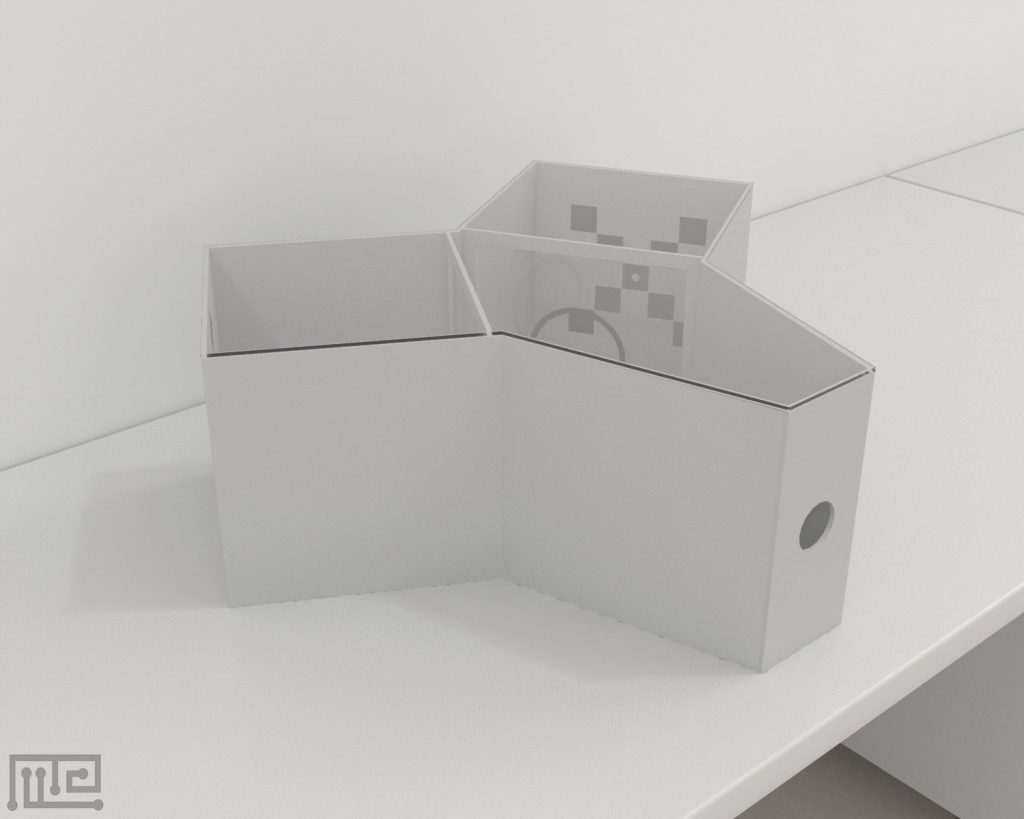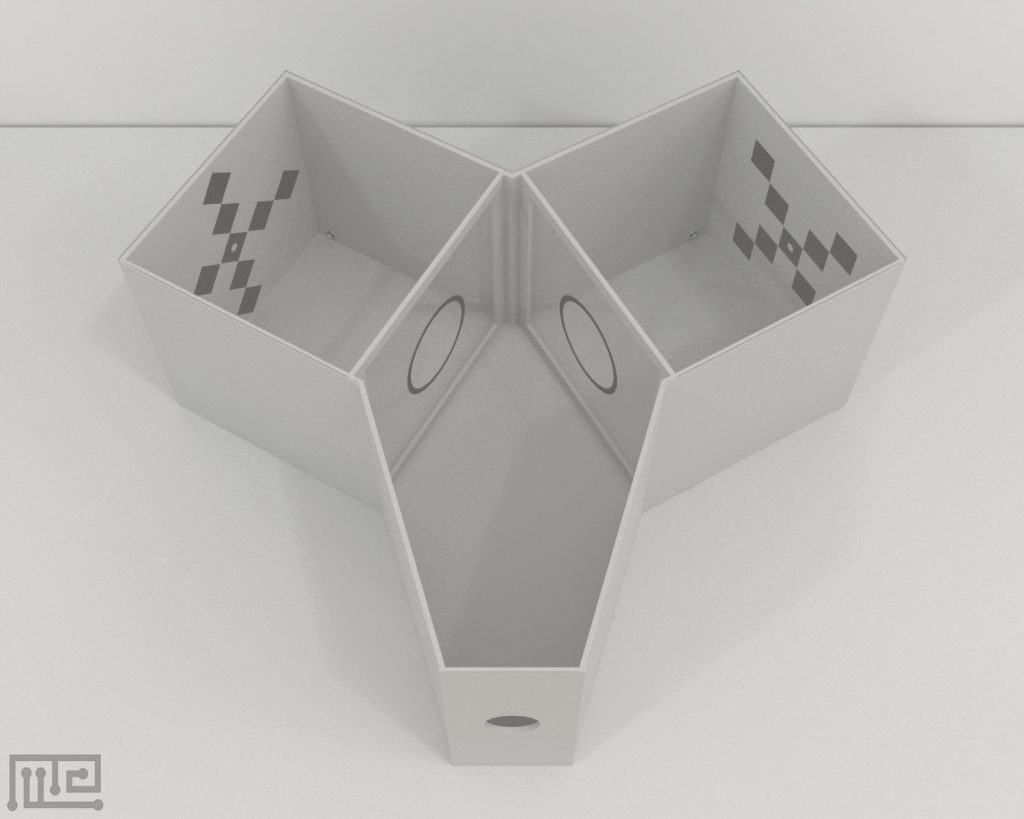The Modified Y Choice For Bees is a choice apparatus used to assess vision in bees. It was used by Horridge, A. (2000). to study orientation in honeybee vision.
The walls of the apparatus are of white card, the top is of clear Perspex. During the study, unwanted recruits tend not to find the circular entrance hole. The baffles of transparent Artistcare Drawfilm are set in a cardboard frame.
Pairs of black patterns on a white background, one rewarded the other not, were presented vertically each in one arm of a Y-maze. During training the locations of the black areas were changed every 5 min to prevent the bees using them as cues, but cues
from edges were kept consistent.
The criterion for a successful choice is whether the bee passes the correct baffle.
Mazeengineers offers the Modified Y Choice For Bees.
Price & Dimensions
Modified Y Choice For Bees
$ 990
+S&H- Length of maze arms: 27cm
- Height of maze: 27cm
- Diameter of circular entrance hole: 5cm
- Width of black annulus surrounding hole at the centre of baffle: 0.5 cm
- Thickness of baffles: 0.13mm
- Width of cardboard frame: 1cm
- Diameter of hole on targets: 2cm
Documentation
Introduction
The Modified Y Choice for Bees is a two-choice apparatus to assess vision in the bees. Bees use two systems of vision processing; they either learn the location of at least one area of the stationary patterns or they use cues from the edges of the patterns (Horridge 2000a; Horridge 1999). The Modified Y Choice for Bees explores the visual processing in bees by exploiting the edge orientations of the patterns, meanwhile controlling location-based cues (Horridge 2000b).
The Modified Y Choice for Bees is similar to the conventional Y maze with an entrance arm that divides into two target arms. The subject enters the maze through a small hole in the entrance arm. It chooses to enter either the positive target arm with a food reward or a negative target arm by looking into the black and white patterns placed on the wall of the target arms. The maze allows subjects to choose the positive target arm by discriminating against the black patterns only through the edge orientations. The Modified Y Choice for Bees task is easy and less time-consuming. It can easily assess vision-based learning in honey bees.
Other apparatuses to study different behaviors in bees include the Honeybee Y Maze, the Bumblebee Y Maze, and the Bee Radial Maze.
Apparatus and Equipment
The Modified Y choice for Bees (27 cm in height x 25 cm in length) consists of one entrance arm having a circular entrance hole (5 cm in diameter). The entrance arm is interconnected with two target arms to create a Y-shaped apparatus. The walls of the maze are made of white cardboard while the roof is made of acrylic. Between the entrance and the target arms, there are transparent baffles (0.13 mm in thickness) with a hole (5 cm in diameter) in the center surrounded by a 0.5 cm wide black annulus. Both transparent baffles are placed in the cardboard frame (1 cm wide). The walls of the target arms facing transparent baffles have a target hole (2 cm in diameter). The hole in the positive target wall provides access to the reward, while the hole in the negative target wall connects with a blind tube. The maze is also provided with different pairs of patterned cardboards (mirror images), which are placed on the target walls and can be easily rotated. Both positive and negative target arms are connected with air pipes to suck residual olfactory cues.
Task Performance
Clean the Maze before and after conducting the task to avoid any residual olfactory cues. Place the Modified Y choice for Bees within 100 m of the beehive so that they can come back to get another reward after 5 minutes of getting a reward. A tracking device such as the Noldus EthoVision can be used to record and observe the movements of the subjects.
Pretraining
Setup the Maze by placing a pair of patterned cardboard in both positive and negative target walls. Conduct the training by allowing bees to enter the Maze through the entrance hole and choose between the positive and negative target hole by looking at the patterns through the transparent baffles. After 5 minutes, change the side of the positive patterned cardboard to prevent the subjects from learning which target hole to choose. Train subjects on one pair of patterns for 10 minutes, followed by training on another pair of patterns for the next 10 minutes. Conduct training for approximately 2 hours. Conduct the training in blocks with 20 choices in each block.
Task
For the Modified Y choice for Bees task, use different patterns from the pretraining. Allow bees to enter the Maze through the entrance hole and choose between the positive and negative target hole by looking at the patterns through the transparent baffles. Provide the reward first at the negative pattern and then at the positive pattern. Conduct tasks for approximately 3 to 4 hours. Conduct the task in blocks with 20 choices in each block.
Literature Review
Investigation of patterned vision through the oriented edge in Apis mellifera
Horridge (2000) investigated the patterned vision of Apis mellifera (honeybee) using an oriented edge as a visual cue. The study subjects included five groups of bees; each group is tagged with five different colors. The subjects were housed in a hive, and their vision was tested using the Modified Y Maze for Bees. The subjects were first trained to choose the target arm with a hole provided with a food reward. Different pairs of targets having black patterns against a white background were vertically placed in the target wall. The sides of the black patterns were oriented every 5 minutes while keeping the edges consistent. The subjects were then tested to see if the subjects were able to find the reward. The results of the study revealed the summation of orientation over the pattern when an array of rectangles and right-angled bars were used as a pattern. The cues situated in the short length of the edge were detected and summed on each fixation side irrespective of the layout of the pattern. The results of the edge polarity revealed that the patterns with saw tooth gratings weakly discriminated against the polarity of the edges. However, they discriminated against the orientation of the faulty line at the point where two gratings join. The subjects were able to discriminate the edge quality. However, they were not able to discriminate against them in unfamiliar orientations. It was observed that with the exclusion of spot location in the target patterns with rows of squares and spots, subjects were not able to discriminate as their net orientation is canceled. The study concluded that changing the location of the black patterns results in a summation of the local orientation cues. However, there is no rearrangement of a pattern on the changed edge orientation of the cue in Apis mellifera.
Data Analysis
- The first correct choice in every 5 minutes
- Number of correct choices in each block
- Mean number of correct choices
- % of correct choices
Strengths and Limitations
- The Modified Y Choice for Bees is a two-choice apparatus to assess vision in the bees.
- It is similar to the rodent Y Maze with one entrance arm that divides into two target arms creating a Y-shaped apparatus.
- The Maze is also provided with different pairs of patterns that are placed in the target arms.
- The subject has to choose between the positive and the negative target arms by discriminating against the black and white patterns through their edge orientations.
- The Modified Y Maze for Bees is a simple, less time-consuming task.
- The Modified Y Choice for Bees effectively evaluates the vision processing system of bees.
Summary
- The Modified Y Choice for Bees is a two-choice apparatus to assess vision in the bees.
- It is similar to the rodent Y Maze with one entrance arm that divides into two target arms creating a Y-shaped apparatus.
- The Maze is also provided with different pairs of patterns that are placed in the target arms.
- The subject has to choose between the positive and the negative target arms by discriminating against the black and white patterns through their edge orientations.
- The Modified Y Maze for Bees is a simple, less time-consuming task.
- The Modified Y Choice for Bees effectively evaluates the vision processing system of bees.
References
- Horridge A. (2000a). Pattern vision of the honeybee (Apis mellifera): blue and green receptors in the discrimination of translocation. Neurobiology of learning and memory, 74(1), 1–16. https://doi.org/10.1006/nlme.1999.3939
- Horridge A. (2000b). Pattern vision of the honeybee (Apis mellifera). What is an oriented edge?. Journal of comparative physiology. A, Sensory, neural, and behavioral physiology, 186(6), 521–534. https://doi.org/10.1007/s003590000103
- Horridge G. A. (1999). Pattern discrimination by the honeybee (Apis mellifera): training on two pairs of patterns alternately. Journal of insect physiology, 45(4), 349–355. https://doi.org/10.1016/s0022-1910(98)00132-2




